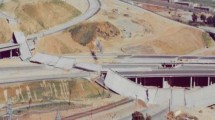Abstract
In this work an integrated procedure for the evaluation of the seismic vulnerability of bridges included in the transportation network and a rational resource allocation for retrofitting with the aim of minimizing the consequences of an earthquake is shown at a network level. Both normal service and post-earthquake emergency conditions are considered as possible scenarios. The final result consists in global delay in the network versus seismic action occurring time. An iterative procedure finally defines the priority for optimal budget allocation for retrofitting. The procedure has been tested on a wide bridge network located in the North-eastern part of Italy.
Similar content being viewed by others
References
Banerjee S, Shinozuka M (2007) Nonlinear static procedure for seismic vulnerability assessment of bridges. Comput-Aided Civ Infrastruct Eng 22(4): 293–305
Basoz N, Mander J (1999) Enhancement of the highway transportation lifeline module in hazus Final Pre-Publication Draft (#7) prepared for the National Institute of Building Sciences
Carturan F, Pellegrino C, Modena C, Rossi R, Gastaldi M (2010a) Optimal resource allocation for seismic retrofitting of bridges in transportation networks. In Bridge maintenance, safety, management and life-cycle optimization-proceedings of the 5th international conference on bridge maintenance, safety and management, pp 1200–1207, ISBN: 9780415891370
Carturan F, Pellegrino C, Zampellini A, Modena C, Rossi R, Gastaldi M (2010b) A procedure for the evaluation of the seismic vulnerability of bridge networks, 14th European conference on earthquake engineering, Ohrid, Republic of Macedonia, August 30th-September 3rd, 2010
Chang ES, Shinozuka M, Moore J (2000) Probabilistic earthquake scenarios: extending risk analysis methodologies to spatially distributed systems. Earthquake Spectra 16(3): 557–572
Choi E, DesRoches R, Nielson B (2004) Seismic fragility of typical bridges in moderate seismic zones. Eng Struct 26: 187–199
Codermatz R, Nicolich R, Slejko D (2003) Seismic risk assessments and GIS technology: applications to infrastructures in the Friuli–Venezia Giulia region (NE Italy). Earthquake Eng Struct Dyn 32(11): 1677–1690
Citilabs (2008) Cube base reference guide, Citilabs
Faccioli E (2006) Seismic hazard assessment for derivation of earthquake scenarios in Risk-UE. Bull Earthquake Eng 4: 341–364
FEMA (2004) Hazus®-MH 20 Technical Manual, Federal Emergency Management Agency, Washington, DC
Franchetti P, Grendene M, Sleiko D, Modena C (2008) Seismic damage assessment for six RC bridges in the Veneto region (NE Italy). Bollettino di geofisica applicata 49(3-4): 513–532
Frank M, Wolfe P (1956) An algorithm for quadratic programming. Nav Res Logist Q 3(1-2): 95–110
INGV (2004) Redazione della mappa di pericolosità sismica prevista dall’ordinanza PCM 3274 del 20 marzo 2003 Rapporto conlusivo per il dipartimento della protezione civile INGV, Milano-Roma (in Italian) (Available online: http://zonesismichemiingvit/elaborazioni)
Jacoboni C, Lugli P (1989) The monte carlo method for semiconductor device simulation. Springer, Berlin
Kiremidijan A, Moore J, Fan YY, Yazla-Li O, Basoz N, Williams M (2007) Seismic risk assessment of transportation network systems. J Earthquake Eng 11: 371–382
Lee YJ, Song J, Gardoni P, Lim HW (2011) Post-hazard flow capacity of bridge transportation network considering structural deterioration of bridges. Struct Infrastruct Eng Maint Manag Life-cycle Des Perform 7(7-8): 509–521
Mander JB, Dhakal RP, Mashiko N, Solberg KM (2007) Incremental dynamic analysis applied to seismic financial risk assessment of bridges. Eng Struct 29: 2662–2672
Morbin C, Casadei E, Pellegrino C, Modena C (2012) Effect of FRP retrofit interventions on seismic vulnerability of existing bridges. In: Biondini F, Frangopol DM (eds) Bridge maintenance, safety, management, resilience and sustainability-proceedings of the 6th international conference on bridge maintenance, safety and management, IABMAS 2012, Stresa, Italy, 8–12 July 2012, pp 1228–1234, ISBN: 9780415621243
RiskUE (2004) An advanced approach to earthquake risk scenarios with applications to different European Town RISK-UE– EVK4–CT–2000-00014
Seville E, Metcalfe J (2005) Developing a hazard risk assessment framework for the New Zealand State highway network Research Report 276, University of Canterbury
Sgaravato M, Banerjee S, Shinozuka M (2008) Seismic risk assessment of highway transportation network and cost-benefit analysis for bridge retrofitting The 14th World Conference on Earthquake Engineering October 12-17, 2008, Beijing, China
Shinozuka M, Tan R, and Koike (1981) Serviceability of water transmission systems under seismic risk. In: Proceedings 2nd specialty conference of the Tech Council on Lifeline Earthquake Eng, 97-110
Shinozuka M, Zhou Y, Banerjee S, Murachi Y (2006) Cost-effectiveness of seismic bridge retrofit. In: Proceedings of third international conference on bridge maintenance, Safety and Management, Porto-Portugal, July 16-19, 2006
Shiraki N, Shinozuka M, Moore JE, Chang S, Kameda H, Tanaka S (2007) System risk curves: probabilistic performance scenarios for highway networks subject to earthquake damage. J Infrastruct Syst 13: 43–54
Torbol M, Shinozuka M (2012) The directionality effect in the seismic risk assessment of highway networks. Structure and Infrastructure Engineering, accepted for publication
Werner SD, Taylor CE, Cho S, Lavoie JP, Huyck C, Eitzel C, Chung H, Eguchi RT (2004) Redars 2 Methodology and software for seismic risk analysis of highway systems
Werner SD, Cho S, Taylor CE, Lavoie JP (2006) Use of seismic risk analysis of roadway systems to facilitate performance-based Engineering and Risk-Reduction Decision Making (Available online: http://www.pwri.go.jp/eng/ujnr/tc/g/pdf/23/23-4-1werner.pdf)
Author information
Authors and Affiliations
Corresponding author
Rights and permissions
About this article
Cite this article
Carturan, F., Pellegrino, C., Rossi, R. et al. An integrated procedure for management of bridge networks in seismic areas. Bull Earthquake Eng 11, 543–559 (2013). https://doi.org/10.1007/s10518-012-9391-6
Received:
Accepted:
Published:
Issue Date:
DOI: https://doi.org/10.1007/s10518-012-9391-6




